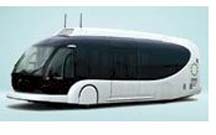Toyota's Intelligent Multimodal Transit System
Overview
The next-generation Intelligent Multimodal Transit System (IMTS) features the following advantages:
* Adjustable capacity As the units in platoon operation (file formation at uniform speeds) are not mechanically linked, it is easy to increase or decrease their number, depending on fluctuations in demand.
* High speed and punctuality Vehicles running in platoons on dedicated roads achieve speed and punctuality suitable for an advanced transit system.
* Excellent multiple-modality Dual mode operation (in a platoon on dedicated roads and as independent units on ordinary roads) allows smooth, limited-transfer travel.
* Route setting flexibility The combined use of dedicated roads and ordinary roads can be flexibly arranged, and this, together with a far-smaller turning radius and the ability to ascend much sharper inclines than is possible with trains, allows flexibility in setting routes.
* High economic efficiency The absence of need for rails and power transformers (which are necessary in conventional rail-based systems), along with the systems compact control system and compact vehicle terminals, etc., contributes to construction and maintenance cost efficiency. Unmanned operation on dedicated roads also reduces labor and related costs.
* Versatility of dedicated roads As the dedicated roads have no rails, emergency and other vehicles can travel on them when IMTS units are not operating.
Technical features
IMTS vehicles are navigated and controlled by magnetic markers imbedded in the middle of their dedicated roads. A thorough fail-safe system is adopted, featuring automatic speed regulation and braking functions assured by inter-vehicle communication, ground signals and other means.
* Course-keeping function Magnetic markers imbedded in the middle of the dedicated roads ensure automatic navigation and control.
* Platoon running function Three electronically linked vehicles run in file formation at uniform speeds.
* Speed-keeping function Stops at stations, departures and traveling speed are automatically regulated in line with the operation timetable.
* Fixed-point stop function Each vehicle in a platoon is controlled to stop exactly at set points along the station platform.
* Anti-collision function Inter-vehicle communication, ground signals and other means allow automatic brake control.
Initial operation at EXPO 2005, Aichi, Japan, beginning March, 2005
At EXPO 2005 Aichi, Japan, IMTS will have the following characteristics
* Leading design Each unit will feature a "Z-CAPSULE" design that gently embraces passengers, projecting an image for a new form of public mobility. Its round and gentle glass cabin, with its esthetically pleasing lines, provides the occupants with a panoramic view
* Dual-mode operation Operation will feature both unmanned automatic operation on a dedicated road and manned manual operation on on-site ordinary roads.
* 3-vehicle platoons, automatic platoon-size adjustment On the dedicated road, three units will run in a platoon; the last unit will automatically separate to travel on an ordinary road when needed and will then automatically rejoin the formation when it returns to the dedicated road.
* Barrier-free consideration Units will feature low floors and will stop at station platforms at a point in which floor height is equal to platform height.
* Environmental friendliness Units will feature clean CNG (compressed natural gas) engines.
Planned operation is as follows
* Period March 25 - Sept. 25, 2005 (185 days)
* Hours 9 a.m. - 10 p.m. (tentative)
Service areas
* Automatic operation zone: uses an IMTS dedicated road connecting the North Gate Station, West Gate Station and South Big Event Hall Station for a total one-way distance of about 1.6 km
* Manual operation zone: operates on an on-site ordinary road connecting the West Gate Station and the Conventional Hall Bus Stop for a total distance of about 0.8 km
* Number of units: 14
* Traveling speed: about 30 km/h maximum and about 20 km/h on average
* Terminal-to-terminal traveling time: about 7 minutes (for automatic operation)
Departure intervals
* Automatic operation zone: every 7.5 minutes (8 departures/hour)
* Manual operation zone: every 30 minutes (2 departures/hour)
Expected passenger volume (rough estimate)
* Automatic operation zone: 27,000 passengers/day (round trip)
* Manual operation zone: 2,400 passengers/day (round trip)
